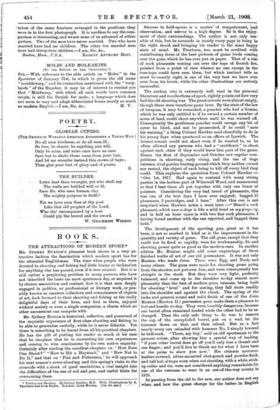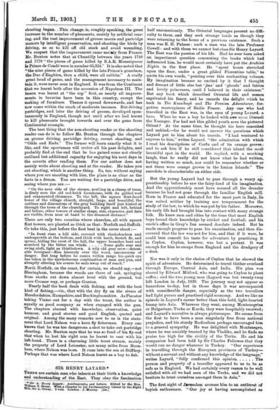BOOKS.
THE ATTRACTIONS OF MODERN SPORT.*
MR. SYDNEY BUXTON'S pleasant book shows in a very at- tractive fashion the fascination which modern sport has for the educated Englishman. The time when people who were devoted to shooting and fishing had little brains or inclination for anything else has passed, even if it ever existed. But it is still rather a perplexing problem to many persons who have not inherited the taste (as most sportsmen do), or acquired it by chance association and contact, how it is that men deeply engaged in politics, or professional or literary work, or pos- sibly known as amateur collectors and connoisseurs of objects of art, look forward to their shooting and fishing as the really delightful days of their lives, and find in them, enjoyed without society or even a single companion, a charm which no other amusement can compete with.
Mr. Sydney Buxton is historical, reflective, and possessed of the requisite experience of first-class shooting and fishing to be able to generalise usefully, while he is never didactic. Yet there is something to be learnt from all his practical chapters. He has the gift of putting the reader so much at his ease that he imagines that he is recounting his own experiences and coming to wise conclusions by his own native sagacity. Certainly after reading the excellent chapters on " How Does One Shoot P" " How to Hit a Haystack," and " How Not to Do It," and that on " Fish and Fishermen," he will approach his next season's cover-shooting and this spring's visits to the riverside with a stock of good resolutions, a real insight into the difficulties of the use of rod and gun, and useful hints for overcoming them.
• Fishing and Shooting. By Sydney Buxton, M.P. With Illustrations by A. Thorburn and from Prints. London: John Murray. [10s. 6d. nat.].
Success in field-sports is a matter' of temperament, and observation, and nerves in a high degree. So le the enjoy- ment of their surroundings. The author is not only sen- sible of this, but he succeeds in nearly every page in being in the right mood, and bringing his reader to the same happy state of mind. Mr. Thorburn, too, must be credited with contributing three of the best pictures of game birds coming over the guns which he has ever put on paper. That of a rise of cock pheasants coming out over the tops of Scotch firs, painted from a point of view whence no one except in the tree-tops could have seen them, but which instinct tells ns must be exactly right, is one of the very best we have ever seen from his brush, while the other illustrations are entirely successful.
The author, who is extremely well read in the personal literature and recollections of sport, rightly points out how very bad the old shooting was. The great coverts were almost empty, though there were vexatious game laws. By the state of the law of trespass, it may be remarked, a poacher who had a license, which be was only entitled to if he owned a certain number of acres of land, could shoot anywhere until he was warned off. Consequently the gentleman poacher could ravage any bit of cover he liked, and not be prosecuted, if he could " save his warning," a thing Colonel Hawker used cheerfully to do in his young days when quartered as an officer at Ipswich. The farmer-tenant could not shoot even if he wanted to, so he often allowed any persons who had a " certificate " to shoot against each other if they would leave him part of the game. Hence the first of September and October saw regular com- petitions in shooting, early rising, and the use of dogs between rival parties beating ground which they neither owned nor rented, the object of each being to kill off every bird they could. This explains the quotation from Colonel Hawker :- " Oct. 1st, 1817. Had again to contend with many strong parties in the lawless part of Wherwell Wood, and manoeuvred so that I beat them all put together with only one brace of pointers. Considering the very bad breed of pheasants, this was one of the best days I have ever enjoyed; bagged 11 pheasants, 3 partridges, and 1 hare." After this one is not surprised when Hawker notes a week later :—" Heard a cock pheasant, which now-a-days is like a wild beast on my property, and in half an hour came in with two fine cock pheasants, I having found another with the one reported, and bagged them both."
The development of the sporting gun, great as it has been, is not so marked in kind as is the improvement in the quantity and variety of game. The old guns, except that they could not be fired so rapidly, were for workmanship, fit, and shooting power quite as good as the modern ones. In another edition Mr. Buxton might add some engravings of those finished works of art of our old gunmakers. It was not only Manton who made them. There were Egg, and Nock, and many others. The guns were made for shooting game going from the shooter, not put over him, and were consequently less straight in the stock. But they were very light, perfectly balanced, and come up to the shoulder to-day almost more pleasantly than the best of modern guns, because, being built for shooting " level" and for aiming, they fall more readily into the shoulder and against the cheek. The spring of the locks and general sound and solid finish of one of the John Manton (Manton II.) percussion guns make them a pleasure to feel and handle to-day. They were horribly dangerous, because one barrel often remained loaded while the other had to be re- charged. Then the only safe thing to do was to remove the cap of the unexploded barrel, put on a wad, let the hammer down on that, and then reload. But as a fact nearly every one reloaded with hammer No. 2 simply lowered to half-cock. " There, my boy," said an old sportsman to the present writer, after showing him a special way of loading, " if your other barrel does go off you'll only lose a thumb and one finger; and you'll live to thank me for what I have been at the pains to show you now." His crimson morocco- leather-covered, silver-mounted shot-pouch and powder-flask, and tall hat, always worn when out shooting, with a white stick- up collar and tie, were not considered anything remarkable for one of the veterans to wear in an ont-of-the-way county in 1870.
In passing from the old to the new, our author does not say when and how the great change for the better in 1tnglish shooting began, c This chauge is, roughly speaking, the great
increase in the number of pheasants, mainly by artificial rear- ing, and the vast_ improvement of grouse moors and partridge manors by intelligent preservation, and shooting the birds by
driving, so as to kill off, old , stock end avoid wounding. We suspect that the improvement came mainly from France.
Mr.' Buxton notes that at Chantilly between the years 1748 And 1778 " the pieces of game killed by S.A.R. Monseigneur le Prince de Conde were in number 65,324." It is also noted that
"the nine pieces of 'game killed by the late Prince's grandson, the Due d'Enghien, then a child, were all rabbits." A really
great head of game, and the management necessary to main- tain it, were never seen in England. It was from the Continent that we learnt both after the accession of Napoleon III. The lesson was learnt at " the top " first, as nearly all improve- ments in luxuries have been in this country, except the making of furniture. Thence it spread downwards, and has now come within the reach of moderate incomes. But driving partridges, and later the driving of grouse, developed spon- taneously in England, though, not until after we had learnt to kill pheasants brought towards and over the guns from
Continental example.
The best thing that the non-shooting reader or the shooting reader can do is to follow Mr. Buxton through, the chapters on grouse driving, partridge driving, covert shooting, and "Odds and Ends." The former will learn exactly what it is
like, and the sportsman will revive all his past delights, and probably find at the end that 'he has gained some not clearly outlined but additional capacity for enjoying his next days in the coverts after reading them. For our author does not
merely write about shooting and at the reader. He takes you out shooting, which is another thing. So, too, without saying
where you are shooting with him, the place is as clear as the facts in a dream. You are waiting for a partridge drive, and seeing where you are :— " On the near side of the stream, nestling in a clump of trees, is dimly seen the old red-brick farmhouse, with its gabled roof and ornamented chimneys. To the left, the square flint-faced tower of the village church, straight, large, and beautiful, the outlines and dimensions of the grey building itself just hinted at through the trees of the churchyard. To right and left, behind and before, other towers of similar shape, size, character, and date are visible, from near at hand to the dimmest distance."
There are only two counties where churches, all with square flint towers, are planted as thick as that : Norfolk and Suffolk. Or take this, just before the first beat in the cover shoot:— "In front rises a hill side, covered with rhododendron and undergrowth at the bottom, and thick with larch, Scotch fir, and spruce, hiding the crest of the hill, the upper branches bent and
scorched by the bitter sea winds Some gulls soar and swing aloft, light as thistledown. A wily old grey crow—detest- able foreigner—flies leisurely over the wood, unconscious of danger. But long before he comes within range his quick eye has taken in the unwholesome combination of man and gun; and abruptly altering his course he sails away out of reach."
North Norfolk, on the coast, fot' certain, we should say,—not Sheringham, because the woods are there of oak, springing from stocks cat down almost level with the ground, but more Cromer way, or perhaps Gunton.
Nearly half the book deals with fishing, and with the best kind of fisbing,—viz., that with the dry fly on the rivers of Herefordshire, Hampshire, and Buckinghamshire. As Piscidor taking Viator. out for a day with the trout, the author is
equally as good company as when engaged with the gun. The chapters abound with knowledge, observation, quiet humour, and good stories and good English, quoted and
original. Among the many remarks new to us is the state- ment that Lord Nelson was a keen fly fisherman. Every one knows that he was too dangerous a shot to take out partridge shooting. Mr. Buxton says that he was so fond of his fly-rod that when he lost his right arm he learnt to cast with his left-hand.., There is a charming little trout stream, mainly the property of Lord Leicester, not many miles from Burn- ham, where Nelson was born. It runs into the sea at Stiff key. Perhaps that was where Lord Nelson learnt as a boy to fish.











































 Previous page
Previous page